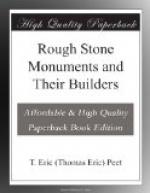These early corridor-tombs are evidently not the work of the Ainu, the aborigines of Japan, but of the Japanese invaders who conquered them. These latter do not seem to have brought the idea of megalithic building with them, as their earlier tombs are simple mounds. As no dolmen has yet been found in Japan we cannot at present derive the corridor-tomb there from it. It is, however, worthy of mention that true dolmens occur as near as Corea, though none have been reported from China.
CHAPTER IX
THE BUILDERS OF THE
MEGALITHIC MONUMENTS,
THEIR HABITS, CUSTOMS, RELIGION,
ETC.
With regard to the date of the megalithic monuments it only remains to sum up the evidence given in the previous chapters. It may be said that in Europe they never belong to the beginning of the neolithic age, but either to its end or to the period which followed it, i.e. to the age of copper and bronze. The majority date from the dawn of this latter period, though some of the chambered cairns of Ireland seem to belong to the iron age. Outside Europe there are certainly megalithic tombs which are late. In North Africa, for example, we know that the erection of dolmens continued into the early iron age; many of the Indian tombs are clearly late, and the corridor-tombs of Japan can be safely attributed in part at least to the Christian era.
With what purpose were the megalithic monuments erected? The most simple example, the menhir or upright stone, may have served many purposes. In discussing the temples of Malta we saw reason for believing that the megalithic peoples were in the habit of worshipping great stones as such. Other stones, not actually worshipped, may mark the scene of some great event. Jacob commemorated a dream by setting up the stone which had served him as a pillow, and Samuel, victorious over the Philistines, set up twelve stones, and called the place “Stones of Deliverance.” Others again perhaps stood in a spot devoted to some particular national or religious ceremony. Thus the Angami of the present day in Assam set up stones in commemoration of their village feasts. It seems clear from the excavations that the menhirs do not mark the place of burials, though they may in some cases have been raised in honour of the dead.
The question of the purpose of stone circles has already been dealt with in connection with those of Great Britain. Alignements are more difficult to explain, for, from their form, they cannot have served as temples in the sense of meeting-places for worship. Yet they must surely have been connected with religion in some way or other. Possibly they were not constructed once and for all, but the stones were added gradually, each marking some event or the performance of some periodic ceremony, or even the death of some great chief. The so-called “Canaanite High Place” recently found at Gezer consists of a line of ten menhirs running north and south, together with a large block in which was a socket for an idol or other object of worship. Several bodies of children found near it have suggested that the monument was a place of sacrifice.




